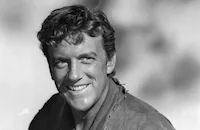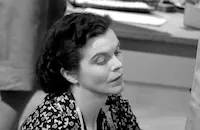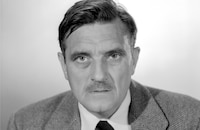Many Rivers to Cross

Brief Synopsis
Cast & Crew
Roy Rowland
Robert Taylor
Eleanor Parker
Victor Mclaglen
Jeff Richards
Russ Tamblyn
Film Details
Technical Specs

Synopsis
In late 18th century Kentucky, a young man named Miles Henderson calls on Noah Crawford and his wife to complain that just as the preacher is about to make his annual visit to town, the Crawfords' daughter Cissie is suddenly reluctant to marry him. Mrs. Crawford blames Cissie's change of heart on handsome trapper Bushrod Gentry, who came to the area several days earlier. Meanwhile, at Bushrod's campsite, the trapper tells the infatuated Cissie that he is not yet ready to give up the wandering life. When Cissie starts to leave, she is attacked by a Shawnee Indian, but Bushrod fends him off with his whip. Next day, Bushrod is hunting in the woods when a group of Shawnee ambush him, but he is saved by a well-timed shot by Mary Stuart Cherne. Mary takes the wounded Bushrod to her family home on Barren River, and her father Cadmus, a garrulous Scotsman, insists that the trapper stay with them a few days. Mary privately declares to her mother that she intends to marry Bushrod. That evening, Mary's suitor, the coarse, ill-tempered Luke Radford, comes by, but Mary refuses to go out with him. Late at night, Mary wakes Bushrod, then takes him to a secret cave and requests a kiss. When she suggests that they discuss their future, however, Bushrod launches into the well-rehearsed speech he recited to Cissie earlier. Determined to remain a bachelor, Bushrod slips away early the next morning, and Mary tells the family's Indian servant Sandak to get Luke. Mary then tracks Bushrod to the river where he is bathing, brings him back at gunpoint and locks him in the shed. When Luke arrives, Mary tells him that Bushrod has insulted her. Boasting of his prowess, Luke challenges Bushrod to battle, and the two men engage in a wild fistfight as Mary's family and neighbors cheer from the sidelines. Bushrod wins, but denounces Mary for her treachery in orchestrating the fight. Cadmus orders Mary to make up with Luke, and the lovelorn young woman stays up half the night trying to think of a way to get Bushrod to marry her. The following day, Preacher Ellis comes to town to conduct a group marriage ceremony. When Bushrod tries to move on that afternoon, Mary's four brothers surround him and hold him at gunpoint, and Cadmus accuses him of seducing her in the cave. Despite his protestations of innocence, Bushrod is forced to exchange wedding vows with Mary. After the impromptu ceremony, Bushrod angrily leaves, unaware that Mary is tracking him. He stops at an inn in Bowling Green, but when the innkeeper tries to make him pay for a dinner he does not want, Bushrod punches him, only to learn that the innkeeper is the justice of the peace. Bushrod is sentenced to thirty days in jail, but is freed from his cell by Mary. As they walk through the woods, Mary feigns exhaustion and insists on stopping to celebrate their wedding night. Bushrod rejects her advances, claiming that he is "sick of being chased like a runaway bull," and they are soon joined by a group of men who are out to avenge a Shawnee attack. Bushrod quickly offers to join the "punishment party," and leaves Mary with two of the men, instructing them to take her back to Bowling Green. With the help of Sandak, who has followed her through the woods, Mary escapes from the two men and sets off after Bushrod. Meanwhile, at a tavern, the party's leader, Esau Hamilton, strikes up a friendship with Bushrod, having heard tales of his exploits over the years. Mary catches up with Bushrod at the tavern and tells him she is ending their marriage and going home to Luke. Inspired by Bushrod's carefree lifestyle, Esau decides to leave his family and become a trapper, but when word comes that his little daughter is sick, he rushes home, accompanied by Bushrod. Bushrod suggests using steam to treat her, and after a long night, the child's fever breaks. Moved by the experience, Bushrod gruffly tells Esau that he has decided to go trapping by himself, and the two men warmly say goodbye. Bushrod starts back to see Mary, and on the way encounters two survivors of a Shawnee raid, who say the Indians are headed toward Barren River. Racing through the woods, Bushrod comes across the badly injured Sandak, who tells him Mary fled when they were attacked by Shawnee. Meanwhile, Mary hides in a hollow tree trunk in the river as four Indians pursue her. Bushrod arrives just as one of them is about to scalp her, and they take shelter in the cave as the other Indians begin to attack. In between quarreling with each other, Bushrod and Mary manage to overcome the remaining Shawnee. The battle over, Bushrod once again starts to leave, but Mary runs after him and announces that he has won her. Happily resigning himself to the inevitable, Bushrod seizes Mary in a passionate embrace.

Director

Roy Rowland
Cast

Robert Taylor

Eleanor Parker

Victor Mclaglen

Jeff Richards

Russ Tamblyn

James Arness

Alan Hale Jr.
John Hudson

Rhys Williams

Josephine Hutchinson

Sig Ruman

Rosemary Decamp

Russell Johnson
Ralph Moody
Abel Fernández
Tom Fadden
Richard Garrick

Darryl Hickman

Dorothy Adams

Louis Jean Heydt

Betty Lynn

Morris Ankrum
Marjorie Wood
William Haade
Dick Rich
Robert Bice
Ethan Laidlaw
Billy Dix
Hank Patterson
Phil Rich
Rudy Lee

George Robotham
Gene Coogan
Carl Pitti
Harry Cody
Joe Mcguinn
Al Ferguson
Hurd Wiese
Crew
Sidney Bowen
Harry Brown
Ridgeway Callow
Jack Cummings
Alvord Eiseman
Cedric Gibbons
Keogh Gleason
Sydney Guilaroff
E. Darrell Hallenbeck
Ben Lewis
Wesley C. Miller
Cyril J. Mockridge
Warren Newcombe
Hans Peters
Walter Plunkett
Robert Saunders
Chuck Scheid
John Seitz
Guy Trosper
William Tuttle
Wally Wallace
Edwin B. Willis

Videos
Trailer
Hosted Intro
Film Details
Technical Specs

Articles
Many Rivers to Cross
This marks the third and final teaming of Eleanor Parker and Robert Taylor, who also worked well together in the World War II drama Above and Beyond (1952) and the archeological adventure story Valley of the Kings (1954). Parker was riding high at this point in her career, coming off two Academy Award Best Actress nominations (Caged, 1950, and Detective Story, 1951) and solid hits in Scaramouche (1952) and The Naked Jungle (1954). Although Many Rivers to Cross didn't make much of an impression either critically or commercially, it didn't halt her career trajectory. She followed this with the true-life biography of Australian opera star and polio victim Marjorie Lawrence, Interrupted Melody (1955), earning her third and final Oscar® nomination, and solid support of Frank Sinatra in The Man with the Golden Arm (1955).
Taylor was one of the last of the famous leading men from MGM's golden days of the 1930s and 40s still under contract to the studio. At the time of this release, he had effectively moved from his beginnings as a dashing romantic figure into his action period (a move made by many of his contemporaries as they aged), keeping his career alive by alternating between Westerns and swashbuckling period adventures like Ivanhoe (1952) and Quentin Durward (1955).
The movie was directed by Roy Rowland, experienced at shepherding other stars past their early prime into Western roles, among them Joel McCrea (The Outriders, 1950), Ray Milland (Bugles in the Afternoon, 1952), and Fred MacMurray and Barbara Stanwyck (The Moonlighter, 1953). Although generally considered a second-string director, Rowland did receive a nomination from the Directors Guild of America for his work on the musical-comedy Meet Me in Las Vegas (1956).
Many Rivers to Cross has no relation to the 1969 reggae song by Jimmy Cliff. Instead, under the credits we hear the traditional tune "Higher Up the Berry Tree" sung by cowboy singer and character actor Sheb Wooley and reprised later in the movie by Parker and Taylor. Wooley began his on-screen career as one of Frank Miller's gang in High Noon (1952). He later had a non-country hit in 1958 with the novelty tune "The Purple People Eater."
Portions of the film were shot on location at Cloverdale and along the Russian River in northern California.
Among the familiar faces in the cast are future Gunsmoke TV Western star James Arness; Alan Hale, Jr. and Russell Johnson, who would appear as the Skipper and the Professor on the comedy series Gilligan's Island; and dancer Russ Tamblyn, who was also in the cast of Seven Brides for Seven Brothers. Academy Award-winner Victor McLaglen (The Informer, 1935) plays Parker's garrulous father, a role similar to the one he played in John Ford's The Quiet Man (1952), for which he received a Best Supporting Actor nomination.
Most notable among the people behind the camera is director of photography John F. Seitz, working outside his usual milieu. Seitz is best known for his moody, evocative cinematography on such great films noirs as Double Indemnity (1944), The Lost Weekend (1945), The Big Clock (1948), and Sunset Boulevard (1950). Although never an Academy Award winner, he was nominated seven times and is one of the most respected and influential masters of shadow and light in Hollywood history. Seitz held eighteen patents for various photographic processes he developed, including lighting devices and methods for making dissolves and matte shots, which he perfected in the 1920s.
Director: Roy Rowland
Producer: Jack Cummings
Screenplay: Harry Brown and Guy Trosper, based on the story by Steve Frazee
Cinematography: John Seitz
Editing: Ben Lewis
Art Direction: Cedric Gibbons, Hans Peters
Original Music: Cyril J. Mockridge
Cast: Robert Taylor (Bushrod Gentry), Eleanor Parker (Mary Stuart Cherne), Victor McLaglen (Cadmus Cherne), Jeff Richards (Fremont), James Arness (Esau Hamilton).
C-96m.
By Rob Nixon

Many Rivers to Cross
Quotes
Trivia
Notes
The film opens with the following written dedication: "We respectfully dedicate our story to the frontier women of America, who helped their men settle the Kentucky wilderness. They were gallant and courageous, and without their aggressive cooperation-few of us would be around to see this picture." Cowboy singer Sheb Wooley sings the song "The Berry Tree" over the opening credits, but the song is also sung in the film by Robert Taylor and Eleanor Parker.
According to a February 15, 1954 Hollywood Reporter news item, Louis Calhern was originally cast in a top role. A May 14, 1954 Hollywood Reporter news item reported that Anthony Nelson would test for a juvenile role, but his appearance in the final film has not been confirmed. James Arness was borrowed for this production from Wayne-Fellows Productions. Portions of the film were shot on location at Cloverdale and along the Russian River, CA. Several reviews compared the film with M-G-M's highly successful 1954 film Seven Brides for Seven Brothers . Many Rivers to Cross was the last of three films in which Taylor and Parker co-starred.

Miscellaneous Notes
Released in United States Winter February 1955
CinemaScope
Released in United States Winter February 1955















